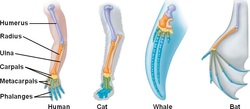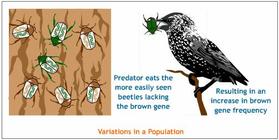Evolutionary Biology

Evolutionary biology is a sub-field of biology concerned with the study of the evolutionary processes that have given rise to the diversity of life on Earth. Someone who studies evolutionary biology is known as an evolutionary biologist; evolutionary biologists study the descent of species and the origin of new species.
|
|
Descent With Modification

Evolution is the change in the inherited characteristics of biological populations over successive generations. Evolutionary processes give rise to diversity at every level of biological organisation, including species, individual organisms and molecules such as DNA and proteins.
Life on Earth originated and then evolved from a universal common ancestor approximately 3.7 billion years ago. Repeated speciation and the divergence of life can be inferred from shared sets of biochemical and morphological traits, or by shared DNA sequences. These homologous traits and sequences are more similar among species that share a more recent common ancestor, and can be used to reconstruct evolutionary histories, using both existing species and the fossil record. Existing patterns of biodiversity have been shaped both by speciation and by extinction. Charles Darwin was the first to formulate a scientific argument for the theory of evolution by means of natural selection. Evolution by natural selection is a process that is inferred from three facts about populations: 1) more offspring are produced than can possibly survive, 2) traits vary among individuals, leading to differential rates of survival and reproduction, and 3) trait differences are heritable.Thus, when members of a population die they are replaced by the progeny of parents that were better adapted to survive and reproduce in the environment in which natural selection took place. This process creates and preserves traits that are seemingly fitted for the functional roles they perform.Natural selection is the only known cause of adaptation, but not the only known cause of evolution. Other, nonadaptive causes of evolution include mutation and genetic drift. In the early 20th century, genetics was integrated with Darwin's theory of evolution by natural selection through the discipline of population genetics. The importance of natural selection as a cause of evolution was accepted into other branches of biology. Moreover, previously held notions about evolution, such as orthogenesis and "progress" became obsolete.Scientists continue to study various aspects of evolution by forming and testing hypotheses, constructing scientific theories, using observational data, and performing experiments in both the field and the laboratory. Biologists agree that descent with modification is one of the most reliably established facts in science. Discoveries in evolutionary biology have made a significant impact not just within the traditional branches of biology, but also in other academic disciplines (e.g., anthropology and psychology) and on society at large. |
Evolution Of Populations

Evolution by means of natural selection is the process by which genetic mutations that enhance reproduction become and remain, more common in successive generations of a population. It has often been called a "self-evident" mechanism because it necessarily follows from three simple facts:
The central concept of natural selection is the evolutionary fitness of an organism.Fitness is measured by an organism's ability to survive and reproduce, which determines the size of its genetic contribution to the next generation.However, fitness is not the same as the total number of offspring: instead fitness is indicated by the proportion of subsequent generations that carry an organism's genes.For example, if an organism could survive well and reproduce rapidly, but its offspring were all too small and weak to survive, this organism would make little genetic contribution to future generations and would thus have low fitness. If an allele increases fitness more than the other alleles of that gene, then with each generation this allele will become more common within the population. These traits are said to be "selected for". Examples of traits that can increase fitness are enhanced survival and increased fecundity. Conversely, the lower fitness caused by having a less beneficial or deleterious allele results in this allele becoming rarer — they are "selected against".Importantly, the fitness of an allele is not a fixed characteristic; if the environment changes, previously neutral or harmful traits may become beneficial and previously beneficial traits become harmful.However, even if the direction of selection does reverse in this way, traits that were lost in the past may not re-evolve in an identical form (see Dollo's law). Natural selection within a population for a trait that can vary across a range of values, such as height, can be categorised into three different types. The first is directional selection, which is a shift in the average value of a trait over time — for example, organisms slowly getting taller.Secondly, disruptive selection is selection for extreme trait values and often results in two different values becoming most common, with selection against the average value. This would be when either short or tall organisms had an advantage, but not those of medium height. Finally, in stabilizing selection there is selection against extreme trait values on both ends, which causes a decrease in variance around the average value and less diversity.This would, for example, cause organisms to slowly become all the same height. A special case of natural selection is sexual selection, which is selection for any trait that increases mating success by increasing the attractiveness of an organism to potential mates.Traits that evolved through sexual selection are particularly prominent in males of some animal species, despite traits such as cumbersome antlers, mating calls or bright colours that attract predators, decreasing the survival of individual males.This survival disadvantage is balanced by higher reproductive success in males that show these hard to fake, sexually selected traits. Natural selection most generally makes nature the measure against which individuals and individual traits, are more or less likely to survive. "Nature" in this sense refers to an ecosystem, that is, a system in which organisms interact with every other element, physical as well as biological, in their local environment. Eugene Odum, a founder of ecology, defined an ecosystem as: "Any unit that includes all of the organisms...in a given area interacting with the physical environment so that a flow of energy leads to clearly defined trophic structure, biotic diversity and material cycles (ie: exchange of materials between living and nonliving parts) within the system."Each population within an ecosystem occupies a distinct niche, or position, with distinct relationships to other parts of the system. These relationships involve the life history of the organism, its position in the food chain and its geographic range. This broad understanding of nature enables scientists to delineate specific forces which, together, comprise natural selection. Natural selection can act at different levels of organisation, such as genes, cells, individual organisms, groups of organisms and species. Selection can act at multiple levels simultaneously.An example of selection occurring below the level of the individual organism are genes called transposons, which can replicate and spread throughout a genome. |
|
